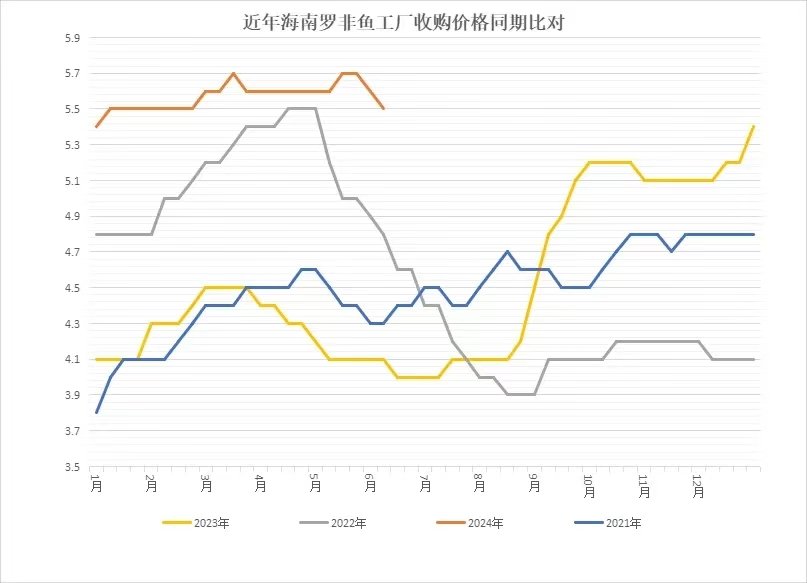Focusing on helping you import competitive frozen tilapia.
18 years of frozen tilapia experience, understand tilapia.
Strong relationships with local big and small plants.
20 years QC, ensure quality.
Tilapia Materials Price Trend
22th,September 2025
All about Tilapia
Introduction of aquaculture
The rising contribution of aquaculture to world fisheries production in contrast to the stabilisation or decline of landings from most wild fish stocks highlights the increasingly important role of aquaculture in satisfying seafood consumption. Wild fisheries and aquaculture production increased from 63 million tonnes and 3 million tonnes in 1970 to 84 million tonnes and 9 million tonnes in 1986 and then, 90 million tonnes and 50 million tonnes in 2007, respectively. These figures indicate that the contribution of aquaculture to total world fisheries production increased from 4 percent in 1970 to 10 percent in 1986 and to 36 percent in 2007. In the near future, aquaculture production for food consumption will exceed landings of wild fish.
Aquaculture is expected to continue to be the main growth force behind world fisheries production for the foreseeable future despite the challenges facing its development. Interestingly, the largest growth from 2004 to 2007 came from the production of catfish, shrimps and tilapia species which grew by 82 percent, 71 percent and 41 percent, respectively. The fast growth of shrimp, catfish and tilapia is due to the expansion in production in developing countries, the increase in international trade and the development of new markets.
Identity of tilapia
Oreochromis niloticus (Linnaeus 1758)
Family: CICHLIDAE
FAO Names: En – Nile tilapia, Fr – Tilapia du Nil, Es – Tilapia del Nilo


Background
The culture of Nile tilapia (Oreochromis niloticus) can be traced to ancient Egyptian times as depicted on bas-relief from an Egyptian tomb dating back over 4000 years, which showed the fish held in ornamental ponds. While significant worldwide distribution of tilapias, primarily Oreochromis mossambicus, occurred during the 1940s and 1950s, distribution of the more desirable Nile tilapia occurred during the 1960s up to the 1980s. Nile tilapia from Japan were introduced to Thailand in 1965, and from Thailand they were sent to the Philippines. Nile tilapia from Cote d’Ivoire were introduced to Brazil in 1971, and from Brazil they were sent to the United States in 1974. In 1978, Nile tilapia was introduced to China, which leads the world in tilapia production and consistently produced more than half of the global production in every year from 1992 to 2003. The development of hormonal sex-reversal techniques in the 1970s represented a major breakthrough that allowed male monosex populations to be raised to uniform, marketable sizes. In addition, research on nutrition and culture systems, along with market development and processing advances, led to rapid expansion of the industry since the mid 1980s. Several species of tilapia are cultured commercially, but Nile tilapia is the predominant cultured species worldwide.
There are approximately 70 tilapia species of which only 10 are farmed worldwide. FAO reports the following farmed tilapia species within its statistics; Nile tilapia (Oreochromis niloticus), Mozambique tilapia (O. mossambica), Blue tilapia (O. aureus), Mango tilapia (Sarotherodon galilaeus galilaeus), Blackchin tilapia (S. melanotheron), Longfin tilapia (O. macrochir macrochir), Redbelly tilapia (Tilapia zilli), Redbreast tilapia (Tilapia rendalli), Sabaki tilapia (O. spirulus spirulus) and Three spotted tilapia (O. andersonii).
According to the Global Seafood Alliance’s (GSA) annual production survey, global tilapia output is estimated to have increased some 2.5 percent in 2021, compared with 1.2 percent in 2020. This marks a significant divergence from growth rates observed over the prior decade and reflects the impact of several developments in the industry. The most important of these is a slowdown in supply growth in China, with an increase of less than 1 percent estimated for 2021. China accounts for around one-fifth of global production, but this share has been declining, with the shortfall in global supply being made up by more rapidly expanding producers in Asia, including Indonesia, Viet Nam and Malaysia, and Brazil in Latin America. Egypt and Bangladesh also produce large volumes of farmed tilapia, primarily for their respective domestic markets, and both are expanding output at a moderate pace of about 3 percent per year. Of all the world’s tilapia suppliers, Brazil has been the standout performer in terms of production growth in recent years. In 2021, tilapia kept its position as the most important species for Brazilian aquaculture and the most exported farmed species. Last year was one of the best years in the history of the Colombian tilapia industry. The country was a top supplier of tilapia to the US market, not only frozen tilapia fillets, but also fresh whole tilapia. In Mexico, tilapia was one of the fish hardest hit by the impact of the pandemic with a sharp drop in sales, particularly in tourist destinations. However, overall the tilapia industry continued to grow, with an annual production of around 60 000 tonnes of fresh fish. In Honduras, the current production of tilapia is more than enough to supply the national market. In addition, the certification of some farms under the Global Aquaculture Alliance (GAA) has opened up more opportunities in export markets.
In the US market for tilapia, there has been active demand in both the foodservice and retail sectors. Consumers have favoured the species over other proteins under the new market conditions imposed by the pandemic However, a series of difficulties has limited the availability of inventory. Chinese tilapia exports have been falling steeply, with the majority of volume now directed to growing markets in Sub-Saharan Africa. In particular, frozen tilapia fillet supplies from China into the United States of America have been affected by several factors, including ongoing logistical issues such as little or no availability of containers, delays in shipments and high freight costs. The shortage is more pronounced for large fillets, as producers had to harvest earlier than planned, and some US players are running out of inventory. This has had a significant impact on prices, pushing them sharply upwards. However, the continuing uncertainty, associated both with the pandemic and the geopolitical tensions between the United States of America and China, is seeing US buyers anxious to ensure they do not run out of stock and purchases continue unabated. According to NOAA , imports of frozen tilapia in the United States of America came to 131 211 tonnes worth USD 452.3 million from January to September 2021 representing a decline of 10.8 percent in volume and 4.18 percent in value compared with the same period of last year. In Latin America, the difficulties faced by China is seen as an opportunity for producers to strengthen their presence in the United States of America. Brazilian tilapia exports reached a total of USD 10.9 million from January to September 2021, which represented 85 percent of the value of all fish exported by producers in the period. Whole frozen tilapia outperformed fresh fillets and was the category with the highest volume shipped in the third quarter of the year. In the domestic market, however, high production costs continue to put pressure on producer and industry margins and the pace of trade is reportedly weak.Driven by the same tailwinds, exports of most other Latin American producers increased over the same timeframe, with the American one remaining by far the most important market.
Production
Main producer countries
Tilapia has been recognised as the perfect farmed fish because it is easy to raise, disease resistant, and readily accepted by consumers from the most marginal consumer markets within developing countries to premium markets in developed countries.
Tilapia’s basic biology, feeding and veterinary requirements allow farmers to produce this fish at a relatively low cost. This has led to a rapid increase in production and has made farmed tilapia the most important component of the tilapia industry.
All tilapia species have very similar characteristics although slight variations such as differences in salinity tolerances affect what species are chosen by producers. Of all the species, Nile tilapia is the most commonly farmed due to its suitability for farming in a wide array of culture systems and environments, ranging from extensive low input pond culture to intensive recirculating systems. By the year 2007, 85 percent of world farmed tilapia production was Nile tilapia.
There are numerous characteristics of tilapia that have encouraged farmers to culture this fish throughout the world. Tilapia can successfully adapt to many different environmental conditions because it tolerates high salinity levels despite being a freshwater fish, high water temperature, low dissolved oxygen as well as high ammonia and nitrite concentrations. In addition, tilapia has a strong resistance to viral, bacterial and parasitic diseases making it very easy to nurse. Also, in contrast to salmon, tilapia’s omnivorous diet makes it cheap and easy to feed. Furthermore, tilapia reproduces and grows fast. Tilapia can grow from fingerling to market size in three months. However, this fast reproduction can also be a constraint because tilapia reaches sexual maturity before it reaches its marketable size. Females then start spawning asynchronously and very frequently, which can lead to overpopulation and stunting.
Oreochromis niloticus main producer countries


Other countries are also significant producers of farmed Nile tilapia but are not recorded on this map for reasons explained within the section of this fact sheet entitled Production.
Production statistics


Tilapias and other cichlids (tilapias in short) are the most popular species group farmed in over 120 countries worldwide with 6 million tonnes of production in 2018, making it the fourth largest species group in global aquaculture. Tilapia aquaculture has been contributed primarily by Nile tilapia (Oreochromis niloticus). The dominance of monoculture farming systems and the globalization of tilapia aquaculture (in terms of information and technology dissemination, production and trade) have led to the concentration of tilapia production (including research and development) towards the most productive species (i.e. Nile tilapia). Other tilapia species have been cultured for specific traits, such as Mozambique tilapia (Oreochromis mossambicus) for high salinity tolerance; hybrid of Nile tilapia and blue tilapia (O. niloticus × O. aureus) for monosex seed; red tilapia (O. mossambicus × O. niloticus) for preferable colour; and Cichlasoma managuense (marketed in China as freshwater grouper) for high meat quality, among others.


China is by far the largest producer of farmed Nile tilapia. By 2019 annual Chinese production had risen to nearly 1 800 000 tonnes and Egypt reported a production of more than 1 000 000 tonnes in that year, while the Indonesia produced more than 1 200 000 tonnes respectively. The other seven ‘top ten’ Nile tilapia producers were Philippines, Thailand, the Lao People’s Democratic Republic, Costa Rica, Ecuador, Colombia and Honduras. Brazil and Taiwan Province of China are also major producers of Nile tilapia and many others, such as Cuba, Israel, Malaysia, the USA, Viet Nam and Zimbabwe produce significant quantities annually. However, the production of these countries is reported to FAO under the general statistical categories ’tilapias nei’ (which may include other tilapia species) and ‘freshwater fishes nei’. It is therefore not possible to include their production data in the above chart until the reporting countries refine their statistical returns to FAO; for the same reason these production locations are not shown in the aquaculture geographical distribution section of this fact sheet.

In China, there are mainly five provinces that farmed tilapia. Guangdong province is the top one producer, which is around 41.51%. Second is Hainan province 20.30% and third is Guangxi province 16.93%.
Market and trade
Tilapia markets are highly diverse. The main local and international tilapia markets supplied by the largest producer regions, namely, Africa, Asia and South and Central America. Tilapia is simultaneously demanded by highly developed western markets, the poorest communities in developing countries and other markets in between. Traditionally, tilapia has been supplied to the poorest in Asia, Africa and South and Central America. Tilapia is native to Africa although tilapia farming was introduced for subsistence in Asia and South and Central America in the 1930s and 1940s. However, tilapia is increasingly demanded in urban markets. This is because production methods have improved quality (no off-flavours or muddy odour), supplied tilapia consistently throughout the year, and produced a variety of products at a reasonable price. This has led local supermarkets to favour tilapia over other freshwater species due to its competitive price and. Furthermore, demand for tilapia has grown fast in highly developed western markets in North America and Europe because tilapia meets the typical preferred requirements for fish; the meat is white, odourless, easy to fillet, and ahas mild flavour. This has resulted in a fast expansion in international trade in recent years as tilapia production in these regions is small and producers in developing countries are able to supply this fish competitively to these markets.
Nile tilapia were introduced to developing countries and cultured on a subsistence level to meet local protein needs. As production techniques improved and off-flavours were controlled, tilapia moved into the mainstream seafood markets of these countries. In highly industrialized countries, small markets for live local tilapia or frozen imports developed among immigrant communities. With the appearance of fresh tilapia fillets from tropical countries, new markets opened in upper echelon restaurants, casual dining restaurant chains, hypermarkets and discount stores. Virtually all casual dining restaurant chains in the USA feature tilapia, which are an ideal menu addition due to their reasonable price, year-round supply, mild, delicious flavour and flexibility in preparation. China, a major exporter of tilapia, has great potential for market development to supply a rapidly growing middle class.
Africa
The largest markets in Africa are situated in the main producing countries, namely, Egypt and Uganda. In 2007, Egypt and Uganda produced 265 862 tonnes and 16 891 tonnes of farmed tilapia, respectively, representing 83 percent and 5 percent of total farmed tilapia production in Africa.
Overall trade within Africa is not well documented. Internationally, some Egyptian producers export tilapia to Saudi Arabia and other Arab and African nations. Zimbabwe and Uganda export tilapia to the EU market. Zimbabwe exports fresh and frozen fillets of farmed tilapia into Europe through Luxembourg. On the other hand, Uganda exports wild caught tilapia. These two countries as well as other African countries are likely to expand their exports to the EU as European tilapia markets slowly expand. Some African countries have exported tilapia to the USA market, although quantities are very limited.
Despite potential increases in African tilapia exports overseas, African markets are expected to continue being the main destination as local demand expands. In southern African markets (Angola, Botswana, Congo DR, Malawi, Mozambique, South Africa, Zambia and Zimbabwe), tilapia consumption has been predicted to expand from nearly 10 000 tonnes to over 40 000 tonnes in five to 10 years. Local markets will be the main destination because production and transport costs together with local prices are likely to continue providing a better return. Furthermore, producers will not require heavy investments in order to reach the quality standards demanded in EU and USA markets.
Asia
In Asia, the largest markets are situated in China, Philippines, Thailand and Indonesia due to their large populations. Other markets with smaller populations are Malaysia, Singapore, Hong Kong, and Taiwan Province of China. Demand has increased in Asian markets since the 1990s due to the increase in population, urbanisation, regular supply, comparatively cheap price and improved quality. These factors have helped turn tilapia into a more popular product shifting consumer preference from expensive marine fish such as red snapper and highly valued culture species such as mullet towards tilapia which is considered to be tasty and cheaper. As a result, there has been an overall increase in consumption of locally produced tilapia as well as an increase in trade within the region.
In below Table, Chinese tilapia exports to the three largest importers and other grouped destinations from 2002 to 2008 are presented. In 2008, the USA imported 58 percent of Chinese exports followed by Mexico and Russia with 18 percent and 8 percent, respectively. The “Other” category refers to unidentified countries in the statistics.
Exports tilapia from China by country of origin


Chinese exports to the five largest destinations in whole-weight equivalents*, in tonnes


Exports tilapia from China by product form


China Customs’ statistics of exportation


According to China Customs’ statistics of Jan.-Nov. 2021(Based on HS16041920 and HS03046100), the first exported quantity is Guangdong, and the second is Hainan, then Guangxi, Yunnan and Fujian.


The total quantity of exportation is 364847239 KG. The exportation is slow down during Feb.-March, because of Chinese New Year.
South and Central America
In South and Central America overall consumption of tilapia has increased due to consumer recognition, higher quality, better marketing and a larger variety of product forms. Brazil, Colombia and Mexico are the three largest markets in the region due to their large populations and aquatic resources. Tilapia produced in these countries is mainly supplied locally because prices are higher than in other markets. In 2007, Brazil, Honduras and Colombia produced 95 091 tonnes, 28 356 and 27 960 tonnes representing 45 percent, 13 percent and 13 percent, respectively, of total production in the region.
Brazil is one of the largest world markets and as such is capable of absorbing most of the production. Most production is sold in local markets. Tilapia, in Brazil, is mainly sold live or whole fresh although processors are expanding the market by supplying fillets and other value added products at competitive prices.
Whilst Brazil is able to supply most demand locally, tilapia imports are increasingly consumed in Mexican markets. This has resulted in Mexico becoming a large importer from China, the USA and a number of South and Central American countries including Brazil and Ecuador.
Other countries in the region have also increased consumption although exports to the USA, the EU, and other South and Central American countries has surpassed local consumption over time. In 2008, the largest exporter of tilapia to the USA was Ecuador followed by Honduras and Costa Rica. In Ecuador large privately owned companies dominate the export-oriented production by controlling the supply chain all the way from the feed mills through to distribution. Vertical integration allows these companies to control the quality of tilapia products and to reduce costs, making it profitable to export tilapia to international markets. Most exports are destined to the USA market. Other markets include Colombia, Mexico, Chile and Venezuela in South America, and the EU.
North America and Europe
Over the last decade, the tilapia markets that have expanded fastest are located in North America and Europe. Tilapia consumed in North American and European markets is mainly imported from producers in South East Asia, South and Central America and Africa. The product forms imported into these markets are whole frozen tilapia, frozen and fresh tilapia fillets. The USA, followed by the EU, has become the world’s largest importer of tilapia.
Imports into USA of tilapia (by product form) by country of origin


Imports into USA of fresh tilapia fillets by country of origin




Imports into USA of whole frozen tilapia by country of origin




Imports into USA of frozen tilapia fillets by country of origin




Imports into USA from various locations in whole-weight equivalents*, in tonnes


In the USA, tilapia has become the third most important seafood commodity imported after marine shrimp and Atlantic salmon. Imports increased from 11 245 tonnes in 1993 to 179 465 tonnes in 2008. China is the major exporter of frozen tilapia products. In 2008, China (Mainland and Taiwan Province) exported 91 percent of the total whole frozen tilapia imported into the USA (49 648 tonnes). For frozen fillets, China (Mainland and Taiwan Province) exported 90 percent of total imports of this product (103 735 tonnes) in 2008. Ecuador and Honduras followed by Costa Rica were the major exporters of fresh fillets in 2008. In this year, these countries exported 32 percent, 32 percent and 21 percent, respectively, from a total fresh fillet import into the USA of 26 082 tonnes.
Mexico is the largest recipient of USA exports. Exports to a number of South and Central American countries including, Aruba and Guatemala, have also increased over time. Exports to North America include Canada and Bermuda. In Europe, the USA is recorded to have exported to a number of countries in different years. These countries are Belgium, Germany, Italy, Netherlands, Portugal, Switzerland, Spain and Ukraine. Exports to Africa and the Middle East are negligible.
The EU tilapia market is still very small, although it is slowly growing. This is due to tilapia being increasingly recognised and appreciated in European markets over other fish such as pangasius and Nile perch. The UK is the largest tilapia market. Despite the efforts at farming tilapia in Europe, most tilapia is imported. We can estimate European tilapia imports were at least 9 000 tonnes in 2008.
Tilapia product forms
An important component of the growing tilapia industry is the proliferation of product forms. Tilapia exports initially consisted of frozen whole fish from Taiwan Province of China, but the USA market preferred fillets, which were initially supplied by Jamaica, Colombia and Costa Rica as a fresh product. Today, fresh or frozen fillets are available in different sizes and packages, as skin-on, skin-off, deep skinned, individually quick frozen, smoked, and sashimi grade, and are treated by carbon monoxide or ozone dipped. Whole or gutted tilapia are still available but are sold primarily in ethnic markets. Interesting by-products have emerged such as leather goods for clothing and accessories, gelatine from skins for time-released medicines and flower ornaments made from dried and coloured fish scales.
Tilapia fillets, IQF, shallow skinned, boneless, with CO treated, which are nice red color.


Tilapia fillets, IQF, shallow skinned, boneless, No CO treated, which is not red color.
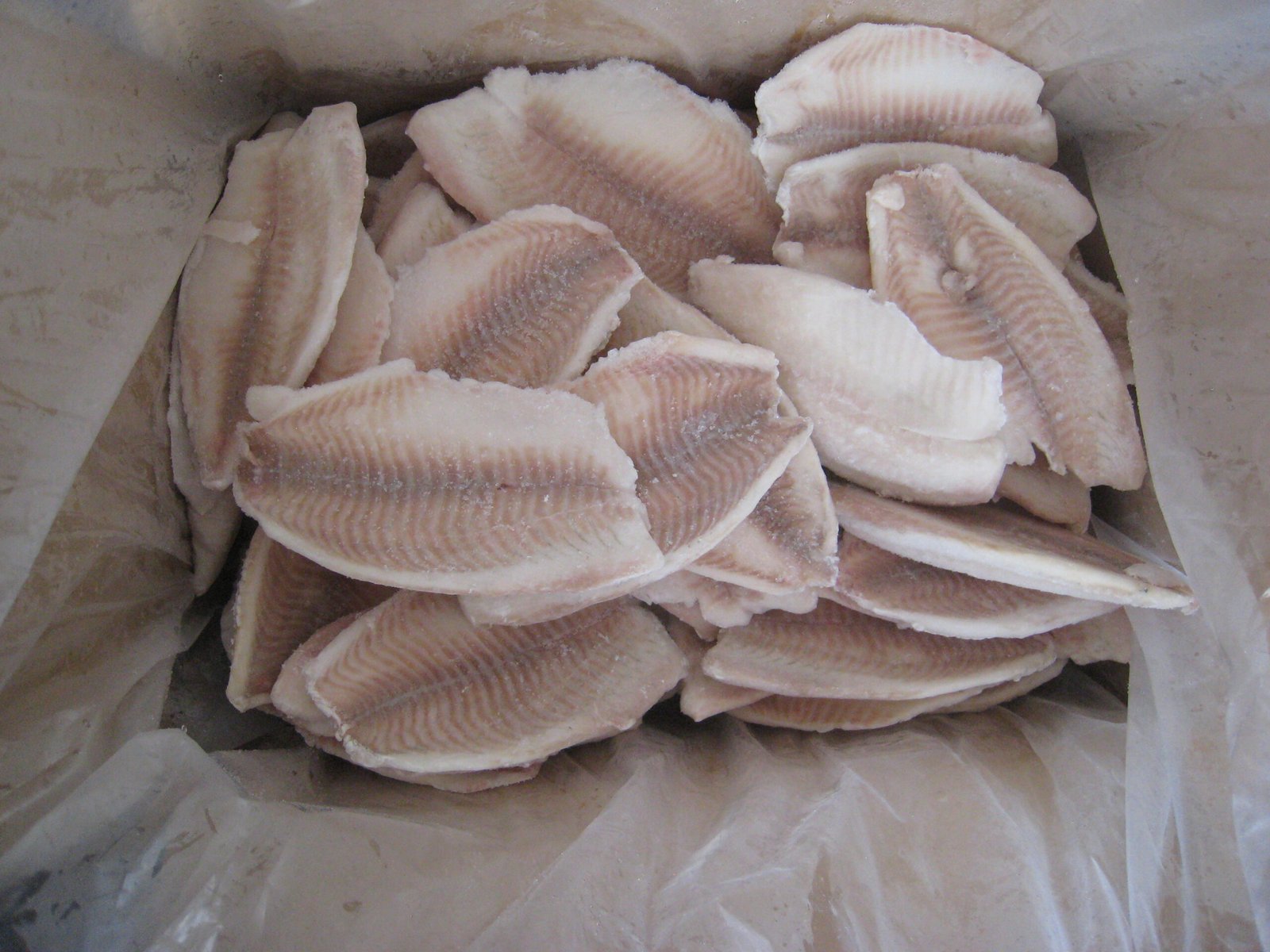
Deep skinned fillets, with blood line on and deep skinned tilapia fillets 1/3 blood line on.
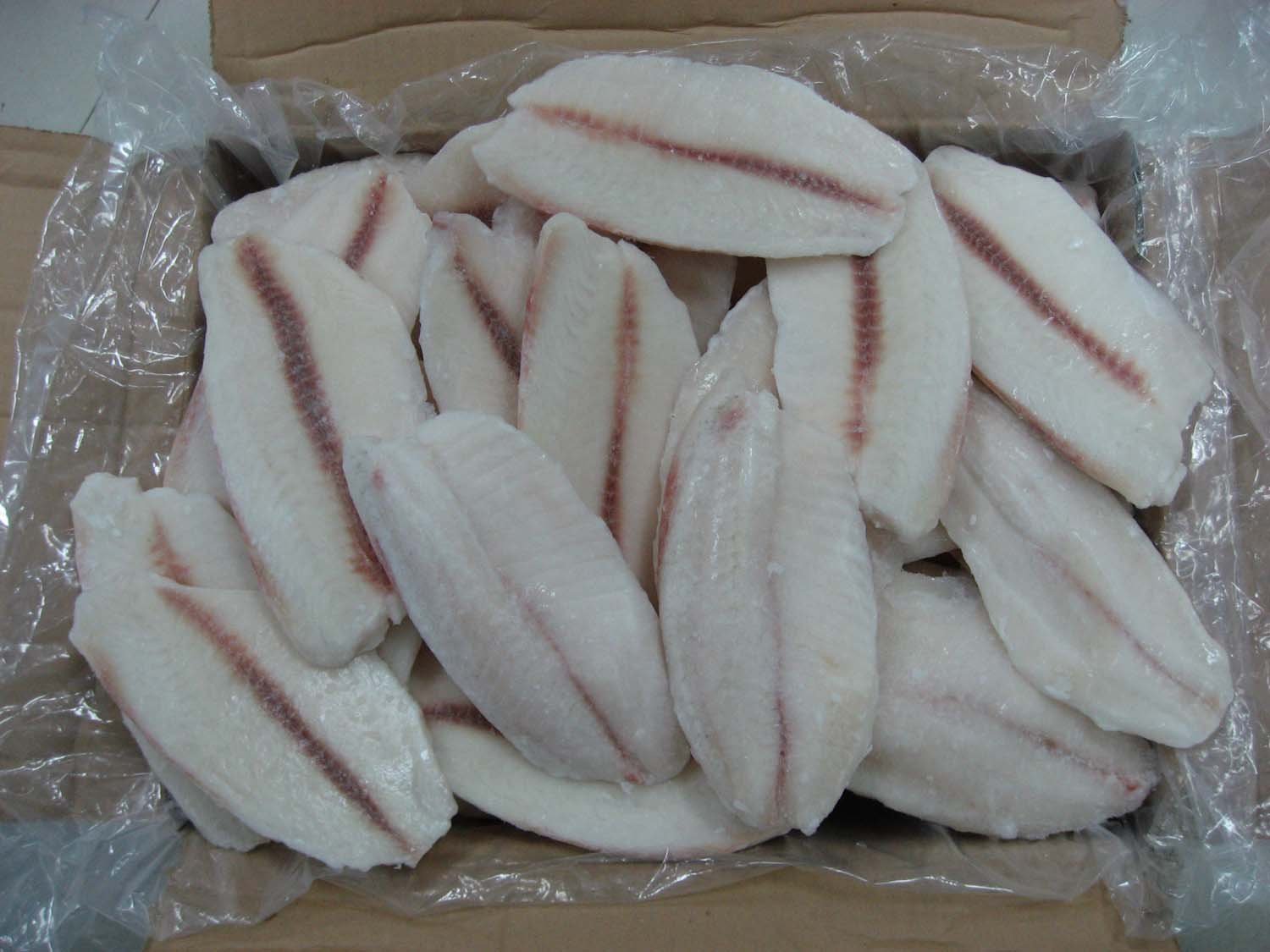
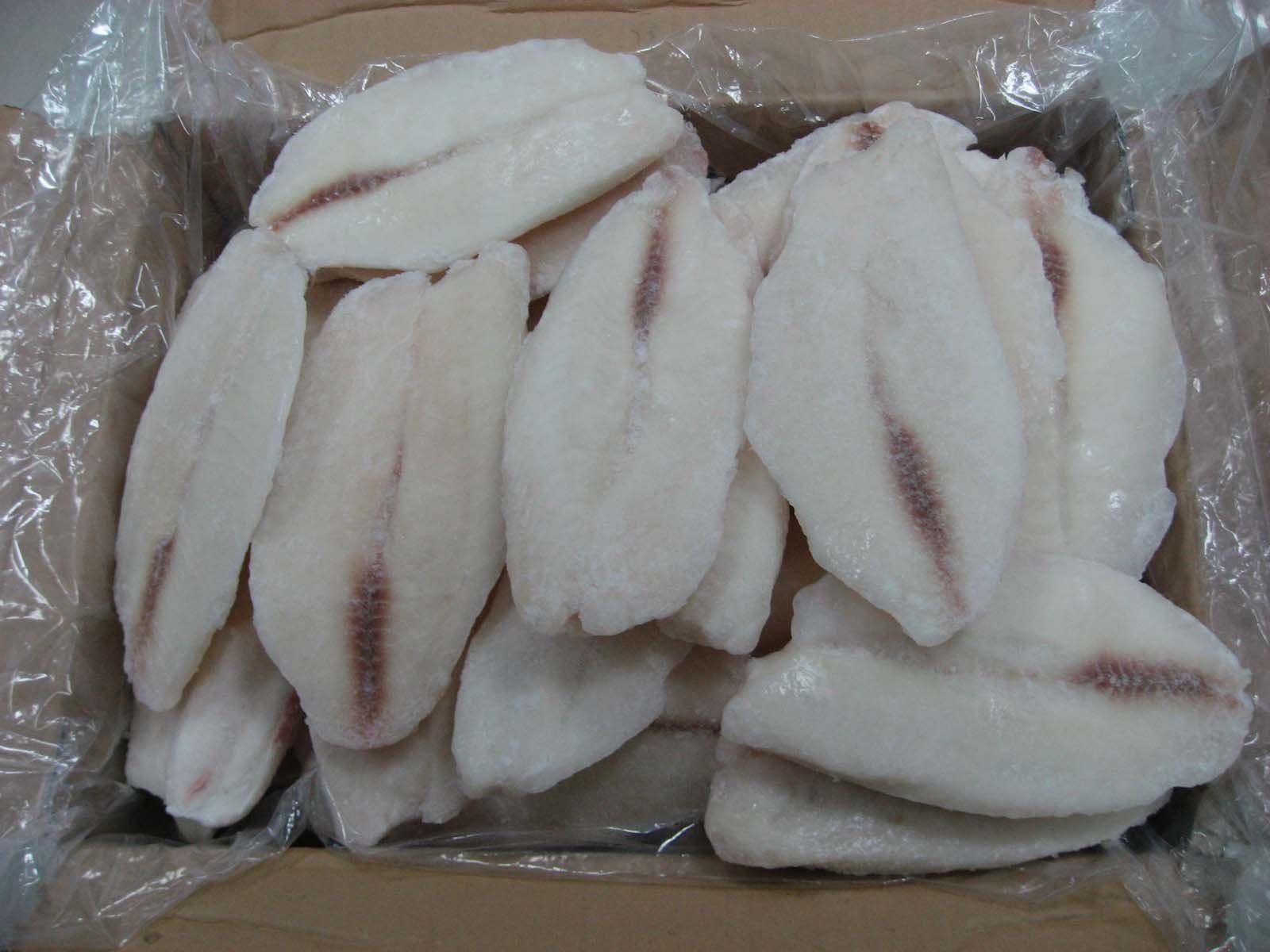
Tilapia GS: Gutted and Scaled, then frozen and packed.
The whole round with no GS is normally for African markets now.

Breaded tilapia fillet. Nice products, but normally small market.
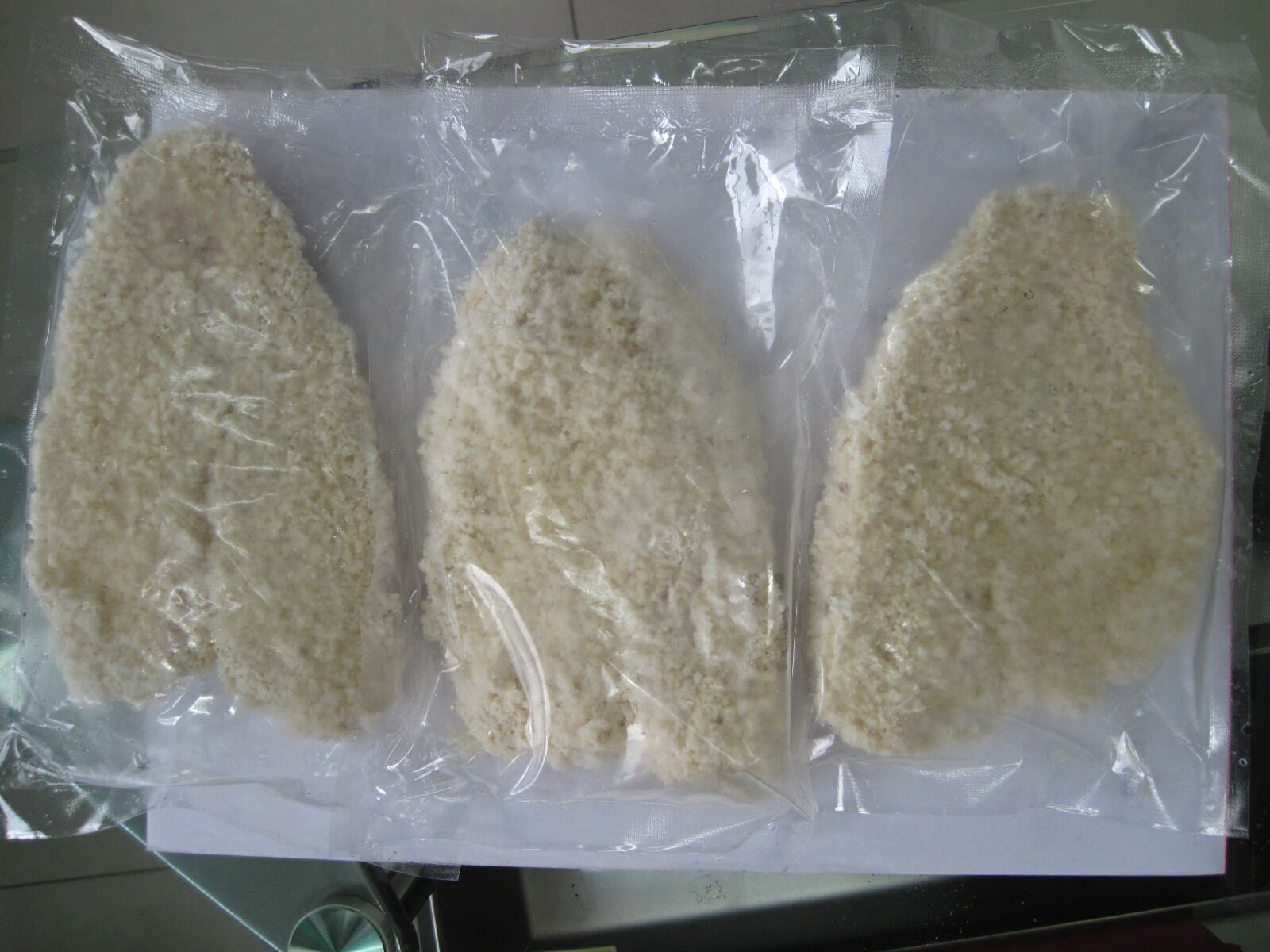

What are IQF, BQF and Semi-IQF?
IQF: individually quick frozen. Each fillet is individual and quickly frozen by the freezing equipment.
BQF: block quick frozen. It needs to be laid on a steel tray with water to freeze in a quick freeze room.
Semi-IQF: Similiar with block frozen, but with less water, and easy to divide to individual.
Normally after IQF, the fillets will be glazed again to get the ice to protect the products. So it can be glazed to 45%glaze. Yes, everyone will say 45%glaze is incredible, but the market needs it too.
What is IVP?
IVP: individual vacuum packing Vacuum packaging keeps the oxygen out to prevent food from spoiling caused by microorganisms. Therefore, deoxygenation can inhibit bacteria and prevent mildew. Another important function of vacuum is to prevent food oxidation. A lot of unsaturated fatty acids are easy to change color and taste. Vacuum can effectively isolate the air and resist oxidation, and maintain the color, aroma, and nutritional value of food.
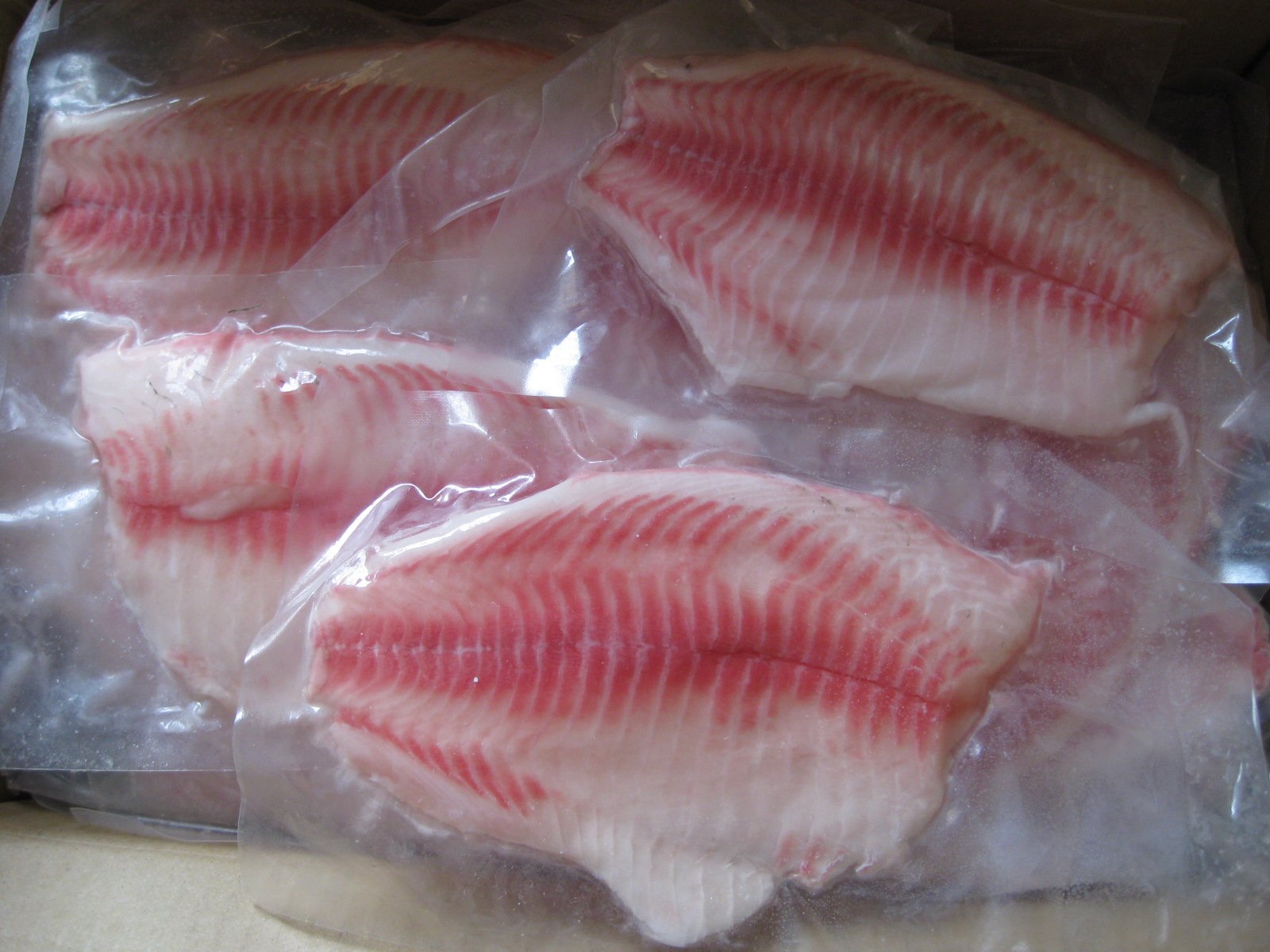

IWP packing with a card on tilapia GS, which is without vacuum.
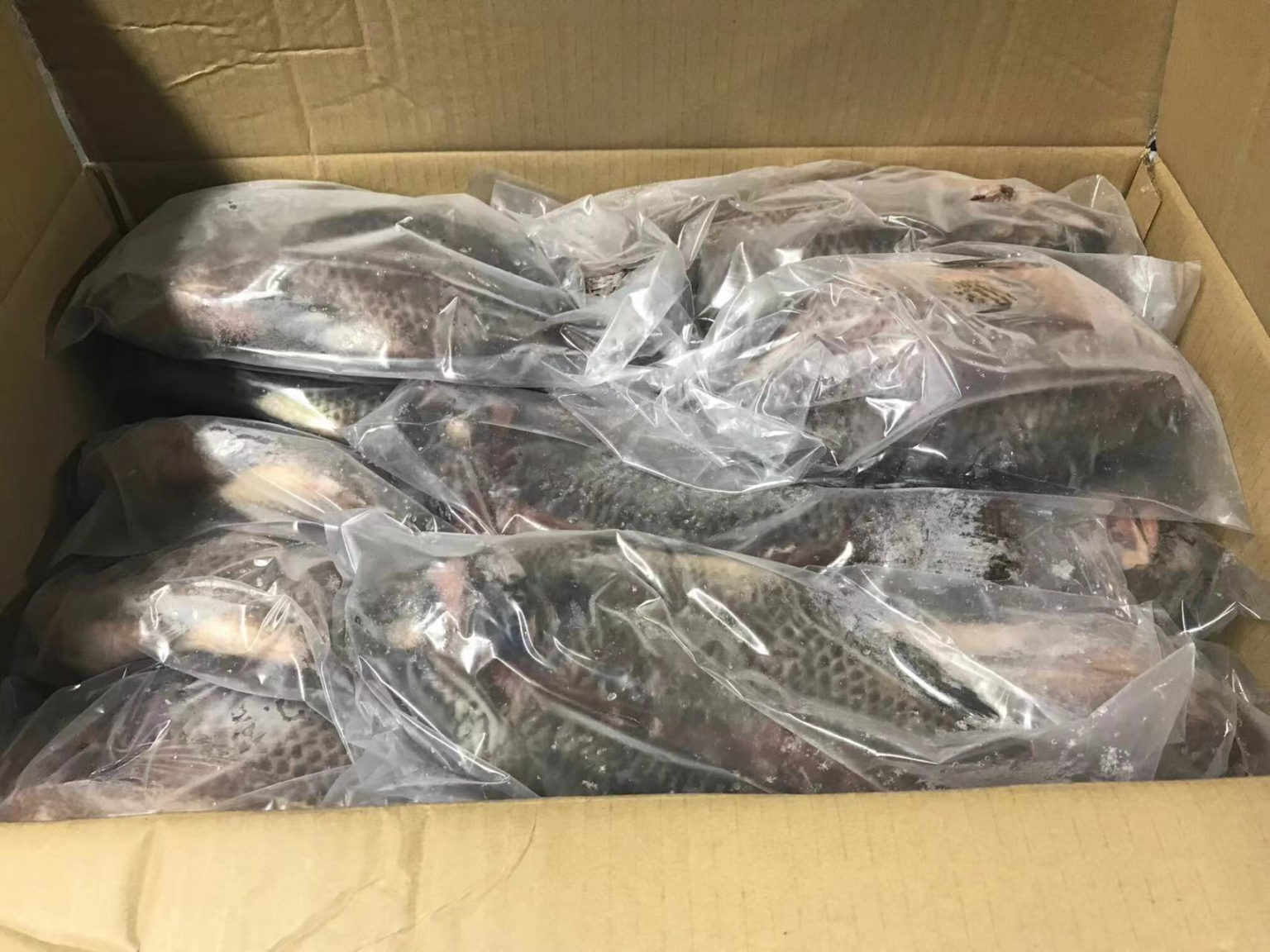

How to process from alive tilapia to fillet?
Show you how to process in the plant from alive fish to fillet as below. Then we will get the shallow skinned tilapia fillet. If we use a deep skinned machine to skin more, then we will get deep skinned with blood line on tilapia fillet. If more deep again, then there will be deep skinned with 1/3 blood line on.
Flow Chart
Alive fish arrival–Blooding–Cutting–Skinning–Trimming–Bone checking–Grading–Washing–IQF Freezing–Glazing–Packing
1. Alive fish arrival
2. Blooding
3. Cutting
4. Skinning
5. Trimming
6. Bone checking
7. Grading
8. Washing
9. Freezing
10. Glazing
Tilapia modern processing at Terrapez using Marel machines
Production cycle of tilapia


Sex-reversal
Commercial tilapia production generally requires the use of male monosex populations. Male tilapia grow approximately twice as fast as females. It is therefore necessary to reverse the sex of female fry. This is possible because tilapia do become sexually differentiated for several days after yolk sac absorption. If female tilapia receive a male sex hormone (17 α methyltestosterone, MT) in their feed, they will develop as phenotypic males. Fry collected from breeding facilities need to be graded through 3.2 mm mesh material to remove fish that are >14 mm, which are too old for successful sex reversal. Swim-up fry are generally <9 mm. MT is added to a powdered commercial feed or powdered fish meal, containing >40 percent protein, by dissolving it in 95-100 percent ethanol, which is mixed with the feed to create a concentration of 60 mg MT/kg feed after the alcohol has evaporated. The alcohol carrier is usually added at 200 ml/kg feed and mixed thoroughly until all the feed is moist. The moist feed is air dried out of direct sunlight, or stirred in a mixer until dried, and then stored under dark, dry conditions. Androgens break down when exposed to sunlight or high temperatures. Fry are stocked at 3 000 to 4 000/m2 in hapas or tanks with water exchange. Stocking densities as high as 20 000/m2 have been used if good water quality can be maintained. An initial feeding rate of 20-30 percent body weight per day is gradually decreased to 10-20 percent by the end of a 3 to 4 week sex-reversal period. Rations are adjusted daily, and feed is administered four or more times per day. If sex-reversal is conducted in hapas, the feed must be of a consistency that allows it to float. Otherwise a considerable amount of feed would be lost as it settles through the bottom of the hapa. Sex-reversed fry reach an average of 0.2 g after 3 weeks and 0.4 g after 4 weeks. The average efficacy of sex-reversal ranges from 95 to 100 percent depending on the intensity of management.
Seed supply
Tilapia are asynchronous breeders. Hormones are not used to induce spawning, which occurs throughout the year in the tropics and during the warm season in the subtropics. Breeding is conducted in ponds, tanks or hapas. The stocking ratio for females to males is 1-4:1 with 2 or 3:1 being the most common. The brood fish stocking rate is variable, ranging from 0.3-0.7 kg/m2 in small tanks to 0.2 – 0.3 kg/m2 in ponds. The popular hapa-in-pond spawning system in Southeast Asia uses 100 g brood fish stocked at 0.7 kg/m2. Spawning ponds are generally 2000 m2 or smaller. In Southeast Asia, a common hapa size is 120 m2.
Brood fish are given high quality feed at 0.5-2 percent of body weight daily. Swim-up fry gather at the edge of a tank or pond and can be collected with fine-mesh nets. Fry collection can begin 10 to 15 days after stocking.
Multiple harvests (six times per day at 5 day intervals) are conducted up to a maximum of 8-10 weeks before pond drainage and a complete harvest is necessary. Tanks must be drained and recycled every 1-2 months because escaped fry are very predaceous on fry from subsequent spawns. Alternatively tanks or ponds are harvested completely after a 2-4 week spawning period. Production of optimum-sized (<14 mm) fry ranges from 1.5 to 2.5 fry/m2/day (20 to 60 fry/kg female/day). In the South East Asian hapa method, fish are examined individually every 5 days to collect eggs. This system is much more productive, but it is labour intensive. Brood fish are more productive if they are separated by sex and rested after spawning.
Nursery
After sex-reversal, fingerlings are generally nursed to an advanced size before they are stocked into grow-out facilities. This procedure increases survival in the grow-out stage and utilizes growing space more efficiently. Sex-reversed fingerlings are stocked at approximately 20-25 fish/m2 in small ponds and cultured for 2-3 months to an average size of 30-40 g. The ponds should be filled immediately before stocking to prevent the build-up of predaceous aquatic insects. Final biomass at harvest should not exceed 6000 kg/ha. In ponds, fingerlings are given extruded feed (30 percent protein) at an initial rate of 8-15 percent of biomass per day, which is gradually decreased to a final rate of 4-9 percent per day. A series of small cages (<4 m3) with increasing mesh size can be used to rear advanced fingerlings. Sex-reversed fingerlings can be stocked at a rate of 3 000 fish/m3 and grown for 6 weeks until they average 10 g. Fish of this size can be restocked at 2 500 fish/m3 to produce 25-30 g fingerlings in 4 weeks. These fish can be stocked at 1 500 fish/m3 to produce 50-60 g fingerlings in 4 weeks. A recirculation system stocked at 1 000 fish/m3 will produce 50 g fingerlings in 12 weeks. Fingerlings should be fed 3-4 times daily.
Production systems Ongrowing techniques
Ponds
Pond culture of tilapia is conducted with a variety of inputs such as agricultural by-products (brans, oil cakes, vegetation and manures), inorganic fertilizers and feed. Annual fish yields using tilapia in polyculture with carps, high levels of agricultural by-products and good stock management can reach or exceed 5 tonnes/ha.In monoculture tilapia systems, animal manures provide nutrients that stimulate the growth of protein-rich phytoplankton, which is consumed by filter feeding Nile tilapia. The nutrient content of manures varies. Water buffalo manure has much lower nutrient levels compared to duck and chicken manure. Obtaining sufficient nutrient levels from manures poses a danger of oxygen depletion from excessive loading of organic matter. Therefore, a combination of manures with inorganic fertilizers is used in low-input production systems. In Thailand, applying chicken manure weekly at 200-250 kg DM (dry matter)/ha and supplementing it with urea and triple super phosphate (TSP) at 28 kg N/ha/week and 7 kg P/ha/week produces a net harvest 3.4-4.5 tonnes/ha in 150 days at a stocking rate of 3 fish/m² or an extrapolated net annual yield of 8-11 tonnes/ha.
Similar yields are obtained solely with inorganic nutrients if alkalinity, a source of carbon, is adequate. In Honduras yields of 3.7 tonnes/ha are obtained at a stocking rate of 2 fish/m2 with weekly application of chicken litter at 750 kg DM/ha and urea at 14.1 kg N/ha. There is sufficient natural phosphorus. Fertilization strategies produce fish to a size of 200-250 g in 5 months. Formulated feeds are necessary to produce larger fish and obtain a higher market price.
To reduce production costs for domestic markets in developing countries, two strategies are followed: delayed feeding and supplementary feeding. In Thailand, tilapia are stocked at 3 fish/m2 and grown to 100-150 g in about 3 months with fertilizer alone, and then given supplemental feeding at 50 percent satiation until the fish reach 500 g. Net harvest averages 14 tonnes/ha, which is equivalent to a net annual yield of 21 tonnes/ha. In Honduras, a yield of 4.3 tonnes/ha can be obtained with weekly application of 500 kg DM/ha of chicken litter and feed application of 1.5 percent of fish biomass for 6 days a week. However, this management regime is less profitable than the use of chicken litter and urea.
Many semi-intensive farms rely almost exclusively on high quality feeds to grow tilapia in ponds. Male tilapia are stocked at 1-3 fish/m2 and grown to 400-500 g in 5-8 months, depending on water temperature. Normal yields range from 6-8 tonnes/ha/crop but yields as high as 10 tonnes/ha/crop are reported in northeast Brazil, where climate and water quality are ideal. Dissolved oxygen is maintained by exchanging 5-15 percent of the pond volume daily. Higher yields of large fish (600-900 g) are obtained in other regions by using high quality feed (up to 35 percent protein), multiple grow-out phases (restocking at lower densities up to three times), high water exchange rates (up to 150 percent of the pond volume daily) and continuous aeration (up to 20 HP/ha). Fish produced through these expensive methods are generally filleted and sold in export markets.
Floating cages
The culture of Nile tilapia at high densities in floating cages is practiced in large lakes and reservoirs of several countries including China, Indonesia, Mexico, Honduras, Colombia, and Brazil. Mesh size has a significant impact on production and should be 1.9 cm or greater to maintain free circulation of water.
Cage culture offers several important advantages. The breeding cycle of tilapia is disrupted in cages, and therefore mixed-sex populations can be reared in cages without the problems of recruitment and stunting. Eggs fall through the cage bottom or do not develop if they are fertilized. Other advantages include:
- Use of waterbodies that cannot be drained or seined and would otherwise not be suitable for aquaculture.
- Flexibility of management with multiple production units.
- Ease and low cost of harvesting.
- Close observation of fish feeding response and health.
- Relatively low capital investment compared to other culture techniques.
However, there are a number of disadvantages, which include:
- Risk of loss from poaching or damage to cages from predators or storms.
- Less tolerance of fish to poor water quality.
- Dependence on nutritionally complete diets.
- Greater risk of disease outbreaks.
Cages vary widely in size and construction materials. In Brazil, cage volumes and stocking densities range from 4 m3 cages stocked at 200-300 fish/m3 to cages 100 m3 or larger stocked at 25-50 fish/m3. Yields range from 50 kg/m3 in 100 m3 cages to 150 kg/m3 in 4 m3cages. In Colombia, cages range from 2.7 to 45 m3 in volume and are stocked with 30 g sex-reversed male fingerlings and raised to 150-300 g in 6-8 months. The fish are fed extruded feeds with 24-34 percent crude protein. Streptococcal infections are a problem, and survival averages 65 percent. Annual yields at final densities of 160-350 fish/m3 are 76-116 kg kg/m3.
Tanks and raceways
Tilapia are cultured in tanks and raceways of varying sizes (10-1 000 m3) and shapes (circular, rectangular, square and oval). An important characteristic of tank design is the effective removal of solid waste; a circular tank with a central drain is the most efficient design. Water exchange ranges from <0.5 percent of tank volume per day in tanks to 180 exchanges per day in raceways. Low exchange tanks rely on nitrification in the water column to remove toxic nitrogenous waste, while raceways depend on water flow to flush waste from the tank.
One type of tank culture, known as a combined extensive-intensive (CEI) system, or Dekel system, recycles water between culture tanks and large earthen reservoir ponds, which serve as biofilters to maintain water quality. The volumetric ratio between the culture tank and reservoir pond ranges from 1:10 to 1:118 or more. Aeration is employed to increase production in tanks because dissolved oxygen is usually the limiting water quality factor.
The maximum tilapia density in raceways ranges from 160-185 kg/m3, and maximum loading ranges from 1.2-1.5 kg/litre/min. A common production level in raceways is 10 kg/m3/month, as water supplies are often insufficient to attain maximum rates. Production levels are considerably lower in tanks with limited water exchange, but water use efficiency is much higher in these systems.
Recirculation systems
In temperate regions, recirculation systems have been developed to culture tilapia year-round under controlled conditions. Although the design elements of recirculation systems vary widely, the main components of recirculation systems consist of fish rearing tanks, a solids removal device, a biofilter, an aerator or oxygen generator and a degassing unit. Some systems apply additional treatment processes such as ozonation, denitrification and foam fractionation. Rearing tanks are generally circular to facilitate solids removal, although octagonal tanks and square tanks with rounded corners provide a suitable alternative with better space utilization.
Drum filters are widely employed for solids removal although other devices (bead filters, tube settlers) are often used. Methods used for ammonia removal consist of a flooded moving bed filter, trickling filter, fluidized sand filter or rotating biological contactor. In oxygenated systems, a stage is provided for vigorous aeration to vent carbon dioxide into the environment. Rearing tank retention times are relatively short (e.g. one hour) to remove waste metabolites for treatment and return high quality water. Most recirculation systems are designed to replace 5 to 10 percent of the system volume each day with new water. This amount of exchange prevents the build-up of nitrates and soluble organic matter that would eventually cause problems.
Production levels in recirculation systems range from 60 to 120 kg/m3 of rearing tank volume, or more. However, the final standing crop is not the best indicator of system efficiency; the maximum daily feed input to a system is a better indicator of both productivity and efficiency. Feed input and other factors that promote production are captured by the production to capacity ratio (P/C), the ratio of system output to maximum carrying capacity. For tilapia, P/C ratios of >4.5 are possible and ratios of >3 may be necessary for profitability. Intensive stock management practices, such as multiple cohort culture with regular partial harvests and restocking, are needed to reach high P/C ratios.
